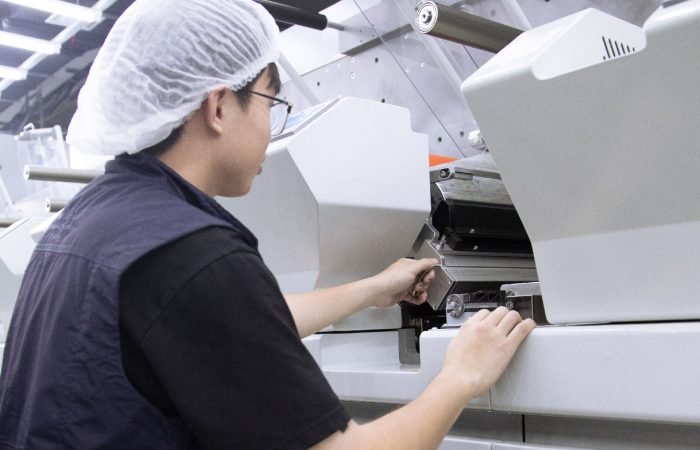Traditional offset printing relies on powder sprays to prevent ink offsetting during sheet stacking. This messy step creates airborne particles, increases waste, and slows production. LED UV technology rewrites the rules by curing inks instantly – no drying time means no need for anti-setoff powders. Let’s break down why this matters across label, flexo, litho, and narrow web applications.
Instant Curing Solves Multiple Problems
LED UV systems emit specific wavelengths that trigger photopolymerization in specially formulated inks. Unlike conventional mercury lamps, LEDs target precise energy levels for immediate cross-linking of molecules. This rapid transformation from liquid to solid occurs in under a second, leaving sheets completely dry. Printers handling pharmaceutical labels or food packaging particularly benefit – no powder residue means cleaner products meeting strict safety standards.
Cost Calculations Shift
Eliminating powder sprays cuts direct material costs by 3-7% depending on substrate and print volume. Indirect savings add up through reduced HVAC filtration maintenance and lower waste disposal fees. A mid-sized label printer switching to LED UV reported 18% faster job turnover from skipping powder application and cleaning cycles. The math gets better: LED units consume 70% less energy than traditional UV systems, with no warm-up delays between jobs.
Substrate Flexibility Expands
Powder-free printing enables thinner materials like 40gsm release liners to run without static issues. Heat-sensitive films for shrink sleeves stay dimensionally stable since LED curing generates minimal IR radiation. One flexible packaging converter doubled their PET film output by ditching powders that caused microscopic abrasions. Even textured surfaces like embossed cartons maintain sharpness – no powder particles settling into crevices.
Color Consistency Improves
Powder spray inconsistencies create mottling effects, especially in gradient areas. LED UV’s instant curing locks pigments in place before oxygen inhibition occurs. A study comparing Pantone matches showed 23% tighter tolerance adherence with LED systems. This matters for brand managers requiring exact colors across cosmetic boxes or beverage labels. The absence of powder interference also allows higher screen rulings – 200lpi becomes achievable for premium wine labels.
Pressroom Air Quality Transforms
Print operators report fewer respiratory issues after switching to powder-free LED UV. Facilities no longer need elaborate dust collection systems, freeing up floor space. A European carton plant reduced their air filtration costs by €41,000 annually while passing workplace safety audits effortlessly. The lack of airborne particulates also minimizes press contamination – fewer blanket washups extend consumable life by 15-20%.
Waste Reduction Adds Up
Every kilogram of unused powder represents €8-12 in direct savings. But the bigger win comes from eliminating spoiled sheets. Traditional powder overload causes 2-3% rejection rates from uneven distribution. LED UV systems slash this to 0.5% through consistent curing. One publication printer reclaimed €28,000 monthly in paper costs alone. Environmental metrics improve too – no powder disposal means lower hazardous waste certifications and simpler compliance reporting.
Hybrid Configurations Emerge
Modern presses combine LED UV with conventional units for strategic powder elimination. A common setup uses LED for base white ink curing while running standard colors. This hybrid approach reduces energy use by 40% compared to full LED systems. Some narrow web operators install LED interdeck units specifically for flood coatings – instant curing prevents powder contamination of subsequent print stations.
Retrofit Options Gain Traction
Older presses don’t require full replacements. Modular LED arrays can integrate into existing drying tunnels. A German converter upgraded their 2008-built flexo press with aftermarket LED modules, achieving powder-free operation at 35% of a new machine’s cost. The retrofit paid back in 11 months through powder savings and new contract wins for dust-sensitive electronics packaging.
Ink Chemistry Advances
Latest LED UV inks achieve rub resistance without post-cure processes. Formulations now include slip additives that replace powder’s anti-blocking function. A major ink manufacturer’s tests show 48% higher abrasion resistance compared to powdered conventional prints. These developments enable powder-free production even for high-friction applications like magazine covers.
The Bottom Line
Printers adopting LED UV technology gain competitive edges through cleaner operations and expanded substrate capabilities. Marketing teams leverage the environmental story – no powder waste aligns with sustainability goals. Production managers appreciate the simplified workflow from eliminating an entire process step. As LED costs continue dropping, the economic case for ditching powder sprays becomes irresistible across all print sectors.












